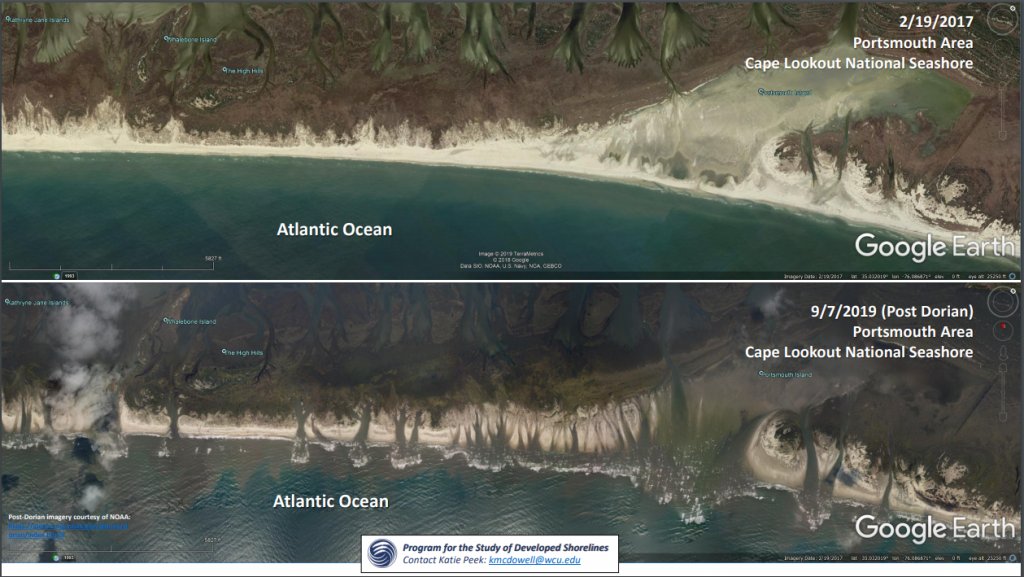North Carolina’s barrier islands (aka the Outer Banks) received the brunt of Hurricane Dorian’s impact to the U.S. mainland, but the damage could have been a lot worse had the storm not been weakened after ravaging the Bahamas as a Category 5 hurricane.
With the devastation of Hurricanes Florence, Michael and Matthew still in recent memory, North Carolinians did not need another reminder of the destructive power of hurricanes. However, Dorian highlighted the particular vulnerability of North Carolina’s barrier islands, and the need for us to develop solutions now for how this region confronts sea level rise and more frequent and intense storms.
Barrier islands losing defense against rising seas
Despite being a Category 1 storm, Dorian cut 54 new inlets into the Cape Lookout National Seashore, proving just how vulnerable the Outer Banks are to storms and sea level rise. Some of the storm-carved inlets may naturally fill in without costly investment. But in areas where the breach extended to the sound, the inlets are expected to widen and deepen quickly as tides and smaller storms cause further erosion to the island and surrounding marshes.
As storms are getting stronger, seas are also rising, resulting in greater damages from increased erosion and storm surges that extend further inland, filling estuaries and swelling rivers. This pressure on the Outer Banks ecosystem will continue to increase until there simply will not be enough sand to keep up, and the barrier islands will be defenseless against sea level rise.

As North Carolina Department of Environmental Quality Secretary Michael Regan recently observed in the Coastal Review Online, Hurricane Dorian shows “that climate change is something that we have to begin to take a serious look at from a planning process.” That is especially true for the state’s barrier islands.
Looking ahead, Western Carolina University Professor Robert Young notes, “I believe that Core Banks may have crossed a threshold where we will see increased dynamism and storm impacts in the future as sea level rise continues. Any infrastructure rebuilding or planning for future infrastructure should be done in light of this new reality.”
It’s time for North Carolina to make a plan
North Carolina must begin planning for the future, learning from other states that have experienced similar damages from rising seas and storms.
After Hurricane Katrina, Louisiana created a Coastal Master Plan to determine how to manage its coastal land loss crisis, including where and when to restore barrier islands. The plan was created with local input and bipartisan support, and has guided an investment of more than $1 billion in restoration funds over the last 10 years.
After Hurricanes Irene and Super Storm Sandy, New York developed a comprehensive resilience plan to guide investments in hazard mitigation and policies aimed at reducing damages. The plan included programs to buy out repetitively damaged properties and encourage restoration of natural infrastructure – an important investment given coastal wetlands helped prevent $625 million in damages during Sandy. Recent hurricanes highlight the need for North Carolina to develop a plan to confront sea level rise and more frequent and intense storms. Share on X
From these states, North Carolina can learn the value of establishing plans to invest over the long term and guide decisions, such as how long to keep the current coastal systems in place and when to begin to shift for the realities of a changing climate. This will require substantial local conversations that cannot be solely led from Raleigh.
North Carolina’s resilience plan must include a clear vision for the future, be science-based to set priorities, and reflect economic and cultural realities. Then it can be used to guide a number of coastal decisions, including whether and where barrier islands should be restored, whether to install natural or hardened infrastructure, and when to let natural processes take their course.
Going forward, North Carolina will be better suited to confront a future with sea level rise and to leverage post-disaster funding if it has a plan in place before the next disaster strikes.










One Comment
Wow, this is why the coast of N.C. keeps getting pounded! The Orrin Pilkey “ let nature take its course” BS of 1974 is the number one reason the coast of N.C. is weakened and gets pounded with every storm. NC allows ncdot to build dunes that direct water into private properties but tell us, the property owners to take the beatings with our hands tied behind our backs. Zero measures of stabilizing or protection since 1974.